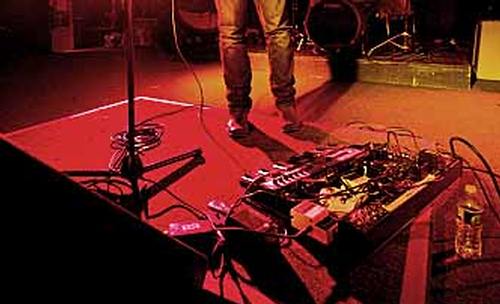You need a pedal that makes it easy to record and play your loops in real time, as well as one that responds immediately to your touch so you can keep your loops in rhythm with your band mates. If you’re the type that likes to plan ahead with your lines, the memory slots and storage features on some loop pedals can make your playing life easier when you do get to the stage.
Here are our suggestions for the 4 best loop pedals for live performance (and we go into detail as to what you should look for in loop pedals after our reviews).
DigiTech JamMan
The storage capability of the DigiTech JamMan is the best on the market. The 99 internal memory slots can store up to 35 minutes of CD-quality loops, while the SD memory card expansion slot adds 99 more memory slots, able to store up to 16 hours of material. This makes the JamMan perfect not only for live guitarists but also for creating backing tracks, for use in the studio, and for DJs. The loop, play, and stop controls are on convenient and clearly-labeled footswitches, and the heavy-duty construction will stand up to the rigors of live performance. Hands down, this is one of the best loop pedals for live performance on the market.
Boss RC-3
If you’re looking for something that takes up a little bit less space on your pedal rack, the Boss RC-3 is a single-pedal looper that gives you high-powered digital signal processing and all the features most people will need in a live performance. The onboard storage has 99 memory slots that can record a total of three hours of music. It also comes with a selection onboard real audio drum loops to help you stay together with your band mates or keep your rhythm in the studio. The simplified layout is easy to both learn to use and to operate on the fly.
TC Electronic Ditto Looper
If you’re looking for a looper pedal that will set you back not too much dough, check out the Ditto Looper from TC Electronic. Its intuitive format strips the loop pedal down to its essential elements, meaning it takes up very little space on your pedal board. The end result is a minimalist layout with a single switch that controls record, undo, stop, and erase functions using different food commands and lets you easily and endlessly record and layer loops. The memory has space for 5 minutes of recording—plenty for playing back and looping lines in live performance. The true signal bypass means your sound goes through the pedal without the signal ever being converted to a digital format, keeping your sound pure. For the money, it’s likely the best loop pedal for live performance period.
NUX Loop Core Guitar Effect Pedal
The recording capabilities of the Loop Core from NUX are extensive, especially for the price. It gives you 99 user memory slots, for a total of over six hours of recording time, plenty for preparing even complicated live performances. You also get an array of overdubbing and layering options, and can switch between layers without any delay. You can even change the tempo of recorded lines without altering the pitch. If you’re a one-man band, you’ll love the 40 included drum patterns, which let you easily add a rhythmic element to your performances. Simply pick the pattern you want and the pedal will automatically match it to the tempo of your loops.
Memory options
How much memory you need in your loop pedal depends on your playing style and intended uses for your pedal. If you’ll be recording as you play when you’re on stage or only need to use it for a tune or two, the five minutes of storage space on the TC Ditto Looper will prove to be plenty. For more elaborate loops—or if you’re a player that likes to prepare an entire set worth of loops ahead of time in the practice room—you’ll get more opportunity to do that with the JamMan, the Loop Core, or the Boss RC-3, all of which give you many hours of potential storage for all your lines.
Size Issues
Some players only use one or two pedals; others have entire racks they bring along to every gig. If you’re in the latter category, the slimmer profile of the Boss RC-3 and TC Ditto Looper will help minimize the load of gear you have to schlep to a gig. The flip side of that is that their simplified controls don’t offer you the on-stage options to quickly cue up memory slots or assign loops to multiple pedals for on the fly switching. The JamMan (see full specs) gives you four potential pedal options along with an array of switches, making good use of its extra size if your pedal rack can handle their bigger footprint.
Loop Effects
The only truly necessary functions for a loop pedal are the ability to record, stop, and play back on demand. A lot of players want to do more with their looped tracks, though, and for that you’ll need a pedal that offers a wider range of functions.
Many loop pedals offer rhythm tracks and options for laying down a beat behind your own lines. These are typically more useful tools for those who use their loop pedal in the practice room and studio, but may be helpful in some on-stage applications.
Decay, fade, and level controls are also fairly common features that give you some amount of control over the shape of your looped tracks. If you want more elaborate controls than that, a larger pedal like the Boomerang Phrase Sampler is going to be your best option. The DJ effects it offers, like the stutter start and half-speed features, are more likely to be necessary for studio musicians or electronic artists than they are for the vast majority of live players, but other effects like synched play and octave doubling will be appealing options for players in a wide range of styles.
Whichever one you choose, it’s really an individual choice when it comes to finding the best loop pedals for live performance. Figure which features are important to you, find which of the 4 above pedals has most of these features, and just get that one. This ain’t rocket science. Good luck!









Thank you so much! This helps a lot